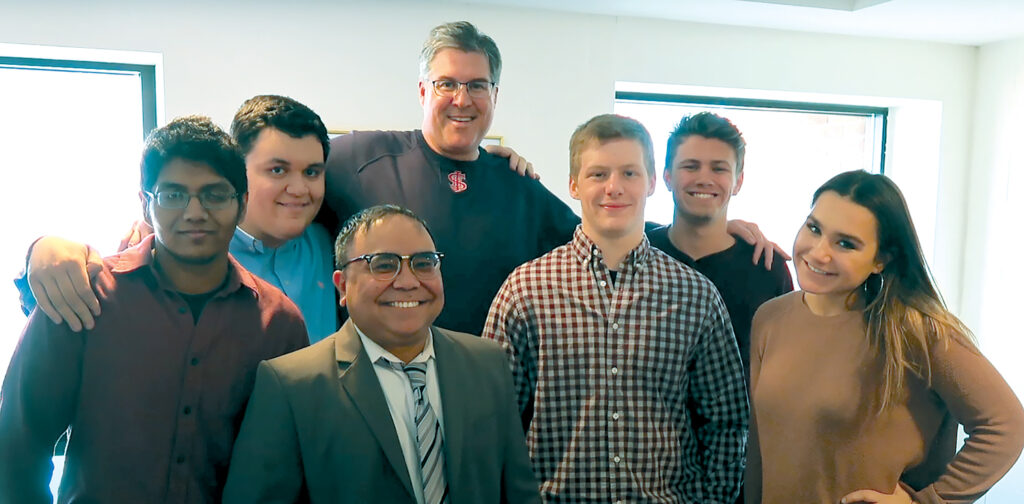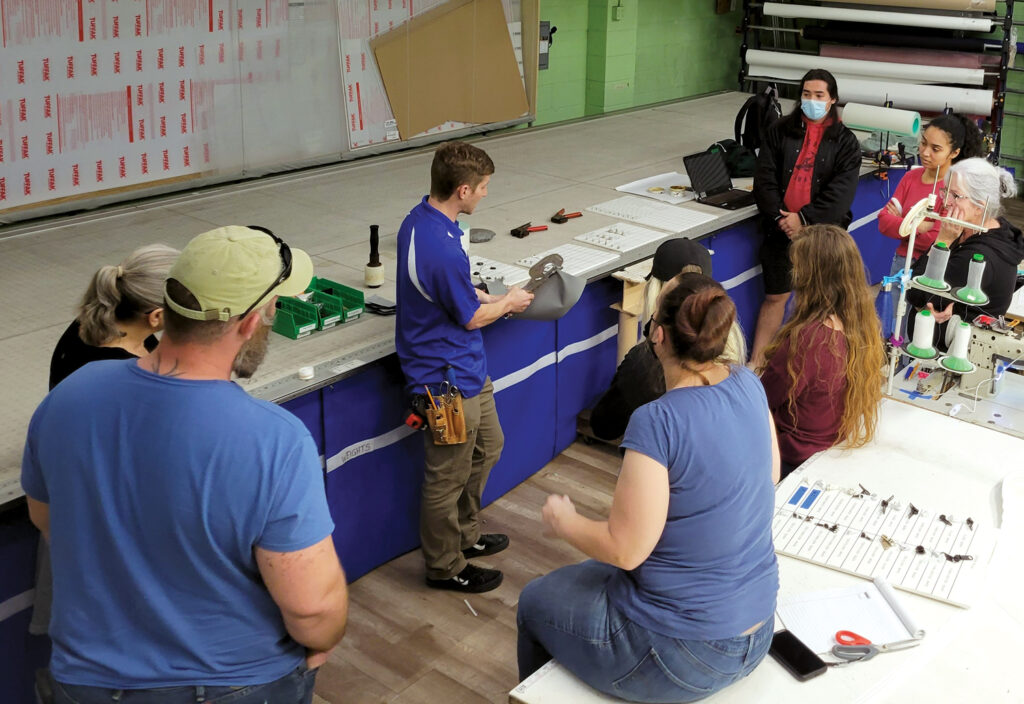
While some organizations are still grappling with quiet quitting or the aftereffects of the “Great Resignation,” textile and fabric manufacturers are facing a somewhat different situation—bringing new employees into the industry, which is a predicament that is becoming increasingly important to address.
“Many of our textiles manufacturers have workforces comprised of older populations that are looking at retirement in the next five to 10 years,” says Robert Finnegan, director of education and workforce development for Advanced Functional Fabrics of America (AFFOA) based in Cambridge, Mass. “The industry staying at full capacity is dependent upon attracting a younger workforce. However, attracting this younger demographic can be challenging.”
AFFOA is one of several organizations Advanced Textiles Association (ATA) is partnering with to address workforce development issues. Its mission is to forge partnerships and relationships that support innovations in fiber and fabric technology. Part of that process is creating new jobs and helping domestic manufacturers hone their competitive advantage.
The organization is taking a multipronged approach to concerns about the dearth of younger workers entering the industry. It is conducting an industry survey of workforce needs and opportunities while also evaluating available workforce solutions. Finnegan says that some in the industry are tackling this issue by establishing apprenticeship and internship programs.

Programs provide a road map
Consider Global Impex USA, headquartered in St. Cloud, Minn. The mill-direct company has warehouses around the country, providing custom fabrics to a diverse range of clients including artists, medical personnel, influencers, athletes and industrial manufacturers, says King Mukherjee, president. The company currently has 10–15 full-time employees and an apprenticeship/internship program that involves five to seven college students.
“In the fabrication industry, apprenticeship programs are necessary,” Mukherjee explains. “I decided to create this program as a long-term approach to help spread the company globally. The internship program provides a road map to giving college students and young professionals a platform to experience the textiles industry.”
The program, developed in 2018, runs between 15 and 18 weeks, with interns expected to work 15–20 hours per week. Interns are recruited through relationships established with major universities across the country, including the Wharton School of Business, University of Florida, Rutgers and the University of Cincinnati. The work is remote/virtual and flexible, with the hours individually determined by each intern.
There are multiple specialized/functional areas in which the interns can train, including sales, sourcing, marketing/sports marketing, finance and accounting, analytics, human resources, e-commerce, supply chain and operations management, and virtual assistance. Interns can progress in stages from freshman to senior, usually staying within their original area of choice.
They interact and work with a diverse team of interns across the U.S., says Mukherjee. Essential skill areas such as time management, development of interpersonal/intrapersonal skills and networking are covered, along with exposing interns to different companies in the industry. Upon program completion, interns receive a certificate as well as a stipend and possibly a bonus.
“Progress is benchmarked by the amount of work they complete each week and how fast they get the work done,” Mukherjee says. “There is an opportunity for an extension, depending on each intern’s performance.”
He says the program has helped the company and its employees in multiple ways, including through networking, diversity and mentorship. He’s also added to his workforce by hiring several interns, including one who is now a general manager.

Offering paid options
Mary Koutras, research and development manager for Duro-Last, says her company also has found new employees through its internship programs. Headquartered in Saginaw, Mich., Duro-Last (a division of Holcim Solutions and Products US LLC) manufactures single-ply PVC roofing membranes for flat- and low-slope-roof commercial buildings for roofing contractors and building owners in the construction industry. The company has 900 full- and part-time employees, with a mix of seasoned staff and newer arrivals.
The company has developed three paid internship programs, says Koutras. One is the “traditional style” where interns balance their college courses with an adjusted work schedule designed to accommodate their classes. Another was created for interns who can work during the summer only. Both of these programs have been in place for more than 15 years.
A more recent one, initiated in 2020 in conjunction with the company’s Research and Development (R&D) department, seeks to provide interns with a more robust R&D experience and project continuity. It has a rotating schedule of three months of schooling followed by three months of an internship, a cycle repeating and lasting throughout the intern’s entire college career. Interns participating in this program are asked to stay for at least two three-month rotations. Koutras says the summer interns have come back for multiple summers and the majority of the rotational interns have returned.
“We acquire traditional and summer interns by having relationships with universities, along with encouraging our internal employees to nominate individuals to Human Resources,” Koutras explains, adding that for the three-months-on, three-off program, the company works with Kettering University, which offers two school sessions: an A and a B. This year there are 15–20 interns in each program.
In addition to R&D, multiple departments support the internships, including HR, marketing, accounts payable, maintenance and safety. Students are given meaningful projects that impact the company, helping with new product development, troubleshooting processes, qualifying vendors and so on.
Time requirements vary. The average number of hours interns attending classes work is around 20 per week, although this can be adjusted depending on the intern’s college schedule, says Koutras. Summer internships are 40 hours weekly; rotational internships are 40 hours weekly with the chance for overtime and three days off for the three working months. At the end of the work term, interns deliver a presentation to key stakeholders, showing what they’ve accomplished as well as sharpening their presentation skills.
“The last three years have been disruptive, from COVID, labor shortages, raw-material supply shortages etc.,” says Koutras. “A benefit we had due to our program is that during the labor shortages, we were able to hire two of the interns when they graduated. We are creating a pipeline of future employees.”

Rewarding skill and efficiency
Signature CanvasMakers has taken a different approach by implementing an apprenticeship program that all new hires, regardless of prior experience, must go through, says CEO Charlene Clark. Headquartered in Hampton, Va., Signature designs and manufactures canvas and textile products such as enclosures, covers, tops and cushions for the government/military, commercial, recreational and residential markets.
As of this writing, the company has 10 full-time and three part-time employees, with three full-time employees and one part-timer in training. Everyone starts out as an apprentice. For example, those on the sewing team must learn all the hems, seams and techniques that go into making their products, says Clark.
“Our pattern/installation team learns the tools, fasteners and other materials we work with, as well as techniques such as drilling and tapping metal,” she continues. “Our digital team learns how to apply definable CAD techniques that increase in complexity to build the products we produce.”
Once a new hire has satisfactorily completed the apprenticeship training, they are given a certificate of achievement and a pay raise. They then can begin working toward their certification levels. There is no timeline for apprenticeship training completion, says Clark, but most finish within one to three weeks, depending on the department and the skills required.
There are four certification levels, covering 20 different project types among them. These fall into the general categories of covers, tops, enclosures, dodgers and cushions/upholstery. As workers move through the levels—department managers oversee progress and provide support, feedback and ongoing training—the complexity and demands also increase.
For example, those vying for Level 4 qualification must be able to manage workflow and train and lead other team members. Moving from Level 1 to Level 4 certification can take several years, says Clark, adding that upon completion of each level, the team member receives another certificate of appreciation and a pay raise.
“Most people don’t come to work for us having any experience in the marine canvas industry,” says Clark, explaining the inspiration behind the program’s creation. “They have never been exposed to the type of work we do and the type of products we create. In order to ensure fabrication consistency at the level of quality our customers expect, everyone needs to be on the same page with what we do and how we do it.”
Efficiency scores are tracked, with each member given an efficiency goal based on their skill level. Team members who exceed their assigned levels are rewarded at the end of each month with various prizes.
“Efficiency/proficiency rates are calculated based on our time standards versus the actual time it takes a team member to complete,” Clark explains. “If we aren’t measuring their progress in a meaningful and timely manner, they have no way of gauging whether they are improving or not, and we have no way to reward them for their success.”
Pamela Mills-Senn is a freelance writer based in Seal Beach, Calif.
SIDEBAR: Training program resources
Not every company wants to or is able to develop its own apprenticeship program. For those looking for other alternatives, the Department of Labor’s (DOL) Registered Apprenticeships (RAPs) program may be an option.
“[It is] aimed at meeting the needs of industry by creating skilled talent pipelines, even with an ever-changing labor market,” says Robert Finnegan, director of education and workforce development for Advanced Functional Fabrics of America. “However, we also know that RAPs require capacity, resources and time to execute correctly, and we are hearing from our industry partners this can be challenging.
“Many of our textiles companies run lean,” he says. “Leveraging technical assistance from organizations who understand the efficient paths to making such programs work could prove helpful for the industry as a whole.”
The DOL’s pre-apprenticeship programs are another potential workforce solution and may prove less cumbersome for companies to navigate, says Finnegan.
“They are slightly more nimble to execute and potentially allow for an easier way to connect with a younger population that is ready to work,” he says. “DOL-supported programs are helpful because they provide financial incentives and are codified, tried-and-true methods of onboarding new employees.”
SIDEBAR: ATA responds to workforce issues
With the aim of addressing the labor shortages and retention issues facing the textile industry, Advanced Textile Association’s newly developed Workforce Development Council (WDC) and the Emerging Technology Council (ETC) are tapping into the experience and know-how of those equally concerned with solving this problem. Some WDC members include King Mukherjee, president of Global Impex USA, Robert Finnegan of Advanced Functional Fabrics of America (AFFOA) and Mary Koutras of Duro-Last.
Current WDC initiatives include developing a national database of available training resources and grants and a program that members can present at local schools to introduce students to the opportunities in the textile industry.
Finnegan says the WDC’s objectives of “supporting the textile industry’s education and workforce needs” align with those of AFFOA’s, which is why he’s excited to be a member.
Mukherjee is an advisory board member of the ETC, and Koutras currently is serving as its chair. Koutras says the ETC’s mission is to provide ATA members with the latest information on industry research and development, innovation, and technology best practices.
“We are also invested in attracting and educating college students and new entry professionals by supporting college events and offering industrial webinars,” says Koutras.
To this end, the committee is developing a Student Ambassador Committee with the intention of giving university students an opportunity to have their voices heard, network and participate in industry events. For more information about the ETC and WDC, contact Janelle Buerkley, member programs manager at janelle.buerkley@textiles.org.
 TEXTILES.ORG
TEXTILES.ORG


